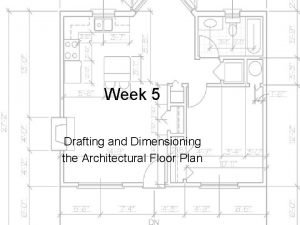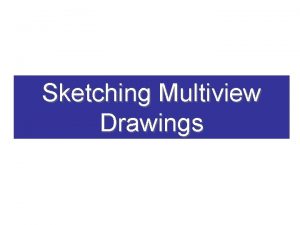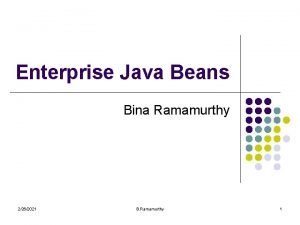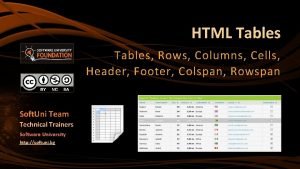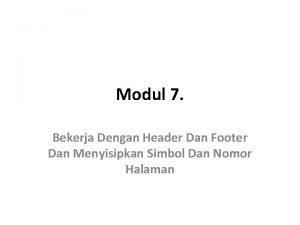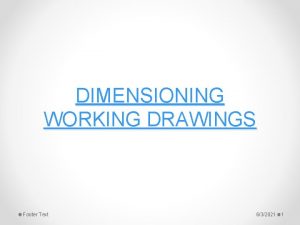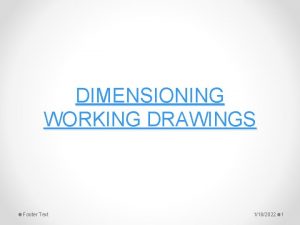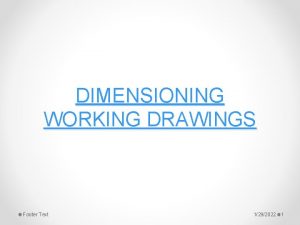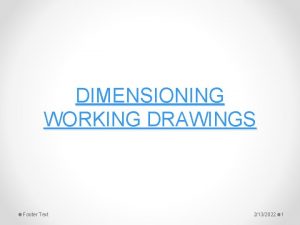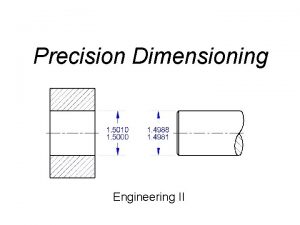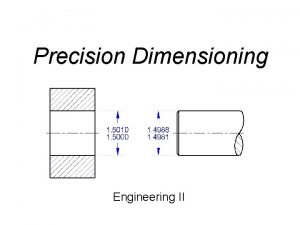DIMENSIONING WORKING DRAWINGS Footer Text 2262021 1 Dimensioning




















- Slides: 20

DIMENSIONING WORKING DRAWINGS Footer Text 2/26/2021 1

Dimensioning Line Types extension lines: • "extends" from the object with a gap of about 1 mm from the object, and continues to about 3 mm past the last dimension lines: • lines with arrowheads carrying the dimension digits. • arrowheads can be represented three different ways; arrowhead, slash, or dot. 2/26/2021 2

Dimensioning Line Types centre lines and reference lines: • alternating long and short dashes which indicates the centre or reference for a particular feature. • these lines may be used as extension lines for dimensioning. leaders: • thin uniform curved lines ending with arrowheads pointing to the feature to which they refer. 2/26/2021 3

Dimensioning Line Types Notes: • In order to completely describe an object, notes are sometimes given on the drawings (e. g. , All rounds and fillets 2 mm radius). • These notes are usually located on the right column of the drawing above the title block. 2/26/2021 4

Dimensioning Symbols • Standard Engineering practices allow for symbols to be used to simplify the drawing. • The following are examples of such symbols: • DIA. O • RADIUS R 2/26/2021 5

Methods of Dimensioning • Aligned: all dimension figures, except those that apply to angular contours should be lettered parallel to the dimension lines. • Unidirectional: all dimensions figures should be lettered parallel to the bottom edge of the paper. 2/26/2021 6

Types of Dimensioning • Overall Dimensions: indicates the overall length, width or height of the object. • Detail Dimensions: provides information about size or location of any feature or detail about the part. 2/26/2021 7

Dimensioning Rules • A technical drawing must always specify the full-size dimensions of an object regardless of the scale to which the drawing has been prepared. • The units of measurement on metric technical drawings are assumed to be millimetres unless otherwise specified. 2/26/2021 8

Basic Dimensioning Rules § Extension lines are solid continuous lines. Leave a visible gap between the feature and the extension line § Extension lines should extend just beyond the dimension line Review

Basic Dimensioning Rules • Place dimensions off, between, or above the views. when possible

Basic Dimensioning Rules • Dimension a feature where its shape is best shown.

Basic Dimensioning Rules • Dimension a feature only once; no duplicate dimensions

Basic Dimensioning Rules • Omit one detail dimension in a chain.

Basic Dimensioning Rules • Dimension to object lines; avoid dimensioning hidden lines

Basic Dimensioning Rules • Place consecutive detail dimensions in line

Basic Dimensioning Rules • Dimension the object rather than the space

Basic Dimensioning Rules • Extension lines begin about 2 mm from the feature being dimensioned. Correct Incorrect

Basic Dimensioning Rules • Dimension obviously identical features only once

2/26/2021 19

2/26/2021 20
 Floor plan dimension standards
Floor plan dimension standards Superimposed dimensioning
Superimposed dimensioning What is multiview drawing
What is multiview drawing Making connections
Making connections 2262021
2262021 2262021
2262021 Stepper motor full step sequence
Stepper motor full step sequence 2262021
2262021 2262021
2262021 2262021
2262021 2262021
2262021 Header and footer
Header and footer Html table footer
Html table footer Semantic elements in html5
Semantic elements in html5 Html cont
Html cont Wkhtmltopdf footer
Wkhtmltopdf footer Adidas header
Adidas header Footer
Footer Working drawings definition
Working drawings definition Smart work and hard work
Smart work and hard work Proses hot working
Proses hot working
